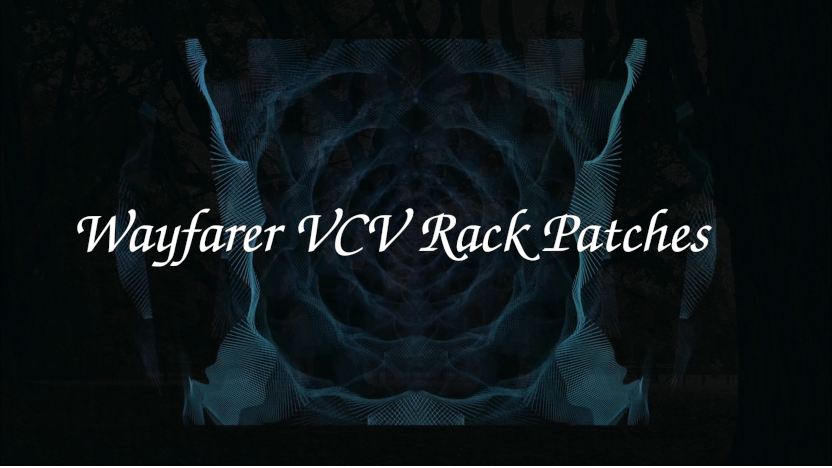
VCV Rack Patches Created for Wayfarer Music
In the composition of Wayfarer music, Dr. Lawrence W. Moore finds the Eurorack modeling software named VCV Rack to be a powerful tool in creating virtual instruments, virtual effects, and compositional environments for music making. This series contains patches that he has been working on recently for the next Wayfarer album release. The series is in video form so that viewers can learn how to make the patches and how to use them.
013 Making a Vocal Drone with Pink Trombone
The web page based synthesizer called Pink Trombone by Neil Thapen has a modular version that is part of the VCV Rack community library as a free module. This module allows one to create voice sounds and vocalizations with tone color controls that relate to the different parts of the vocal tract, such as tongue, throat, and windpipe. In this episode, we make a patch that can be used as a voice pad with sound transformations that allow it to go from smooth to rough and from one vowel sound to another. This is a powerful module and is a lot of fun to work with.
012 MIDI Controller Mapping & Simple Hammond Organ Emulation
In this episode, we will focus on two things. First, we will look at the 2 main ways one can map MIDI CC (continuous controller) messages in VCV Rack so that a MIDI controller can be used as a physical controller for sounds. Second, we will be using these approaches in order to control a patch that uses the Squinky Labs Hammond Organ emulator called Organ Time. Organ Time is a great way to achieve Hammond Organ emulation in VCV Rack. After working with these techniques, you will be able to make your own organ sound in VCV Rack that sounds beautiful and dynamic. You will be able to transform the sound on the fly like one can with a real Hammond organ.
011 – Exploring the Elements of Early Electro-Acoustic instruments
With the launch of the new live stream, Ear Worms, Dr. Lawrence W. Moore of the Wayfarer Project has been studying some of the early innovations in electronic and electro-acoustic instruments. Many of the early instruments in electronic music history are better described as electro-acoustic instruments because of how much of a role acoustic properties play in the creation of their sound. This is especially true for the musical telegraph invented by Elisha Gray and the Ondes Martenot invented by Maurice Martenot. In this episode, we will design a sound that has elements of the Onde Martenot and the Theremin in it both in its electro-acoustics and is control design.
010 – Drone Sequence & Distorted Lead Combo Sound
In this episode we see how to make a drone sequence that can also function poly phonically allowing you to play the same sound as a lead. This lead can also do simple harmonies and still sound good. It does have a complex timbre to it and the modulation wheel can be used to morph the sound significantly. The overall sound is distorted, but in a refined way that still sounds high quality with just the right overtones being accentuated and modulated. The sound is largely composed of modules from SurgeXT, using the Alias module as the core oscillator. There are a lot of parameters to Alias that allow one to make some really cool sounds. The overall episode is a learning experience for folks who are looking to design their own sound patches in VCV Rack.
009 – Making a Lo Fi Medieval Distorted Resonator Lead with Drone
In the ongoing search for cool sounds that can be made in VCV Rack, this sound came about during the course of events. It has a medieaval quality to it that sounds like a cross between a reed organ, and a bladder instrument similar to a bagpipe. When using the mod wheel to adjust the filter and the resonance, the sound becomes a lo fi electronic distorted resonator. The overall sound is quite dynamic and can produce subdued medieval qualities, as well as some screaming distorted lead qualities. The drone can be utilized in both flavors. One really needs to hear the sound a bit to truly appreciate it. The lo fi distorted electronic world merges with the dark, Gothic world.
008 – Making an Auto Generating Trippy Trance Sequence with Live Mixing
In my exploration of ideas for an upcoming album release, I decided to try to make something that would be somewhat auto generating in that it would give my a dynamic sequence that I could manipulate, change, and orchestrate through live mixing. I decided to use the drum modules from SV Modular as well as the clock generating and sequencer. Then, I used the mscHack envelope pattern sequencer to make changes to tuning, panning, and other parameters in the sequence. I used the Audible Instruments Macro Oscillator to generate formants for a drone as well as w ailing chant. The result from the original to the one produced in the episode are quite different, but it goes to show how dynamic this process works and how flexible it can be.
007 – Synthesized Shamanic Drumming Part 2 – Cricket Nature Sounds
Now that we have a solid bass drum rhythm and shakers to ornament that rhythm, it’s time to add some nature sounds to the experience. In this episode, we see how to add cricket sounds to our synthesized shamanic drumming patch in VCV Rack. The crickets really help the sound experience to lift to a whole new level of power with a really hypnotic effect. The crickets sound in and out of time with the drum beat in such a way that it really helps the mind to let go. We use VCV brand modules to make these cricket sounds and put them in their own space with a the SurgeXT Reverb.
006 – Synthesized Shamanic Drumming Part 2: Making Shaker Sounds
As we continue our journey in making synthesized shamanic drumming sounds, we now turn to making shaker sounds. The shaker is an important part of shamanic drumming instruments and it helps to create that hypnotic state that is the whole purpose to the drumming. Now that we have the bass drum sound, we need a shaker. In this episode, we see how to make a shaker sound using noise. A few different flavors of noise are tested out. We use the segment envelope generator from mscHack to great effect in creating the shaker rhythm. It also helps us to control changes in the VCF and panning of the sound. With the filtering, the shaker sounds more realistic and with the panning, the hypnotic effect rises to a new level. Once again, the VCV Rack noise module helps us to select the right noise color, and the SurgeXT VCF helps us to find the right filter for the job.
005 – Synthesized Shamanic Drumming Part 1: Bass Drum Sounds
Let’s see if we can do some shamanic drumming in VCV Rack by exploring some of the sounds, effects, and possibilities that would contribute to a hypnotic, drum circle-like experience. We will be handling this in parts. This first part is establishing a good rhythm for the bass drums. Using two different modules to create two different pitches of bass drum, this sequence seems to work well for shamanic drumming. The equalized version of the drums with chorus sounds pretty realistic and clean. The delay allows for the rhythmic pulsing to take on it’s own life. The mscHack accent sequencer is the sequencer used and the SV Modular Marionette Bass Drum module is used for the bass drum sound. The SurgeXT Delay, Chorus, and Reverb modules round off the effects.
004 – Drum & Formant Sequence – Hypnotic Tribal Drumming
This episode explores a patch that really gets into a hypnotic state of consciousness with a drum sequence and synthesized formants. The effect is like a shaman singing with a drum beat. We look at how one can use the SV Modular sequencer and drum modules to create a pretty cool beat easily and then use the SurgeXT Delay module to add some echo-like polyrhythmic action that is really trance inducing. As the idea evolves, we add the formant sounds from the Audible Instruments Macro Oscillator. Finally, we see how to execute the whole sequence with MIDI as a one note, one key groove.
003 – Using a Node Sequencer and Delay to Make Tripped Out Drum Patterns
In this episode, Dr. Lawrence w. Moore shares a patch that he was working on to make drum patterns that were hypnotic, trippy, and just all out magical. The patch demonstrated int his video shows one some insights on making drum patterns for hypnotic or trance inducing purposes. The patterns can be varied using some parameter changes on the node sequencer as well as on the delays for the different drum sounds. The node sequencer from Sha#bang! is utilized to generate the drum triggers and the tuning of the drum sounds. The SurgeXT delay is used to create rhythmic delay patterns on the drum sounds. The drum sounds are from the SV Modular drum kit. VCV Rack has a whole plethora of options when it comes to making tripped out drum sounds. This is just one.
002 – Auto Generating Minimalist Pattern/Pulse Rhythmic Mallet Tones
In this episode we will look at a VCV Rack patch made by Dr. Lawrence W. Moore that has the sound of mallet tones being played in a pattern/pulse minimalist still with rhythmic variations. There are many ways to make this kind of sound in VCV Rack, but Dr. Moore elected to utilize the Node Sequencer from Sha#Bang! so that a collection of pitches could be selected and executed at different octaves. The Audible Instruments Macro Oscillator 2 is also used to generate filtered noise that has a pitch to it. This noise can then be used in reverb to sound similar to a mallet instrument. The oscillator generates a rhythmic flow of tones. This can be further shaped with the Befaco ADSR envelope generator. The panning is then randomized and attenuated using the VCV Random module and Befaco attenuator respectively. The resulting sound is an auto generating flow of notes from the mode or key that you select with interesting rhythmic variations in the minimalist pattern/pulse style.







